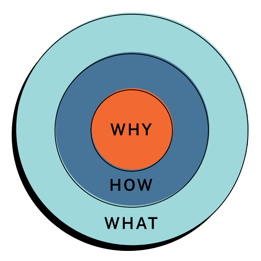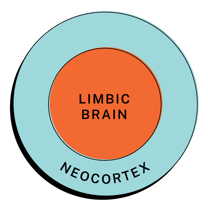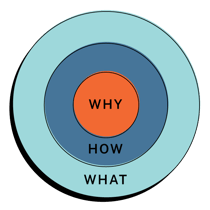How Great Leaders Inspire Action

You tell people what your nonprofit does.
But do you inspire them with why you do it?
There are lots of causes in the world, and lots of good folks active in promoting them. Through websites and various communication venues, they always tell us what they do (and to some extent how they do it).
Yet, when nonprofits rely on reaching and keeping a donor or corporate giver, do they communicate their core belief, their higher purpose? In other words, how many actually say why they are doing what they do?
According to inspirational speaker Simon Sinek, not many. And that can hurt those seeking donor dollars.
To illustrate—yesterday at the supermarket, a friend of mine lingered a bit to overhear an exchange between a passerby and a person holding up a cardboard sign that read, “Please help - Need money for propane - Cold nights for family.”
The passerby said, “I don’t mind helping people in need. But I see notices all over town offering employment, including here. What are you doing to earn money? Why are you asking for mine?”
The sign holder said something vague about a hardship, but evidently his answer to “Why?” wasn’t compelling enough to make any money change hands.
Sinek relates successfully answering “why” to communicating an inner passion that gets people to believe in you. He notes that true leaders, whether people or organizations, are very effective at doing this.
For example, while many individuals participated in the 1960s civil rights movement, only a handful commanded numerous followers. They knew the power of passion, of belief by people in why they were involved, why they cared. The masses didn’t follow Dr. King because he said, “I have a plan,” but rather he mesmerized them with “I have a dream.”
Sinek tells us why “why” is so important with his Golden Circle theory.
What exactly is the Golden Circle?

Back in 2009, Simon Sinek gave a TED talk about his “Golden Circle” theory, which became a “do this” for any business that wanted to successfully communicate with its market.
And let’s face it—nonprofits have markets, too, consisting primarily of donors and corporate entities. There are only so many giving dollars, and nonprofits compete to attract them. Thus essentially, like their for-profit counterparts, nonprofits vie for market share.
But back to the Golden Circle. It consists of three rings with “Why” in the center, then “How” and finally “What” on the outside. Sinek says most firms communicate from the outside in, with all saying what they’re pushing and some adding how. Generally, why these firms do what they do is absent from their communication.
On the other hand, leaders communicate from the inside out, starting with why they do what they do. They have a real belief in why they exist, compelling donors, customers, and supporters to choose them over competitors because they feel that same belief.
What makes this Golden Circle work?

 My turn to say “why.”
My turn to say “why.”
Sinek equates the Golden Circle’s outer “What” ring to the brain’s neocortex that controls language along with rational and analytical thought. It handles information and language.
The limbic brain aligns with “how” and primarily “why.” It’s responsible for behavior and emotional responses like loyalty and suspicion and has no capacity for language.
By communicating what they do first, most organizations tap into people’s neocortex with lots of data like programs, services, features, benefits, and the like. The neocortex can process this vast amount of information, but it can’t drive a person’s behavior.
Conversely, instead of saying “what we do” first, the communicator uses a convincing “why we believe in what we do” to tap into the limbic brain instead of the neocortex. The goal here is to inspire people to buy, to donate, or even to be hired based on their gut feeling and not what they think. Basically, it evokes a powerful, primal response.
I’d have to go along with most of that. We at CauseMic define our why as wanting to empower cause-driven organizations to be fully funded to do the most good. We communicate this core belief with our cultural principles that stress doing the tough work, rejecting the status quo, showing rather than telling, and having fun along the way.
Our belief resonates with a lot of folks, some of whom ultimately become our clients or even part of our team.
At CauseMic, we believe “why” makes for a persuasive story.
Take our client DigDeep, for example. They bring clean, running water to those without it by planning locally led water projects. With their Water Council of sponsors covering costs, DigDeep applies 100 percent of their donations to funding programs.
That’s their what and how. According to DigDeep’s website, why they are in business is: “We believe that every American has a right to clean, running water.”
Using our technical expertise to communicate this core belief, CauseMic helped DigDeep surpass their year-end revenue and engagement goals. Their passion for access to safe water being a universal right was clear and unmistakable, inspiring donors to act with a 273 percent increase year over year.
Or take the Selamta Family Project. Almost 10 percent of Ethiopian children are orphans. United with a Selamta-trained mother, eight to ten orphans can grow up together in the same household. Along the way, Selamta provides this “forever family” with wrap-around care including education, wellness, spiritual, and psychosocial support.
And why do they do what they do? “We believe every child deserves the love of a family.” Simple yet powerful, this definitely stirs something in most of us. It’s what enabled CauseMic to create and communicate impactful narratives, significantly growing revenue for Selamta and securing them a corporate partnership with Travelocity.
So, is the Golden Circle theory the alpha and the omega?
To be honest, I think there’s a lot to be said for the Golden Circle. Without really knowing it, we’ve operated that way quite a bit from the beginning. Cause-driven groups exist because of an authentic belief in why they do what they do. We capture that in an emotional appeal when telling their story.
However, that said, sometimes people aren’t looking for beliefs or visions. Rather than being inspired to act on a gut level, they just want a solution. Like Harvard Business School professor Theodore Levitt once put it, “People don’t want to buy a quarter-inch drill bit. They want a quarter-inch hole.”
So for the best perceived value, Walmart instead of Bombas gets the nod for a six-pack of socks. In other words, it’s cheap and it gets the job done, and no visceral reaction is going to change the consumer’s mind.
But for the most part, making people believe in why bypasses their conscious thought process and hits them where it counts. For our cause-driven clients, that impact means a donation.
I’m Matt at CauseMic. Let’s chat!
.png?width=400&height=300&name=CM-blog-Power%20of%20Research%20(1).png)


